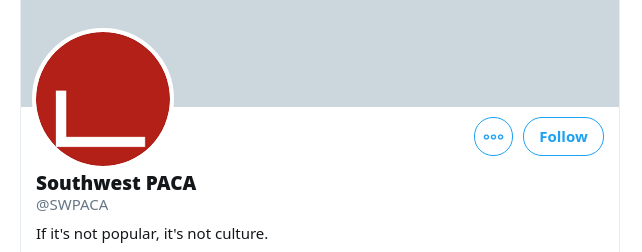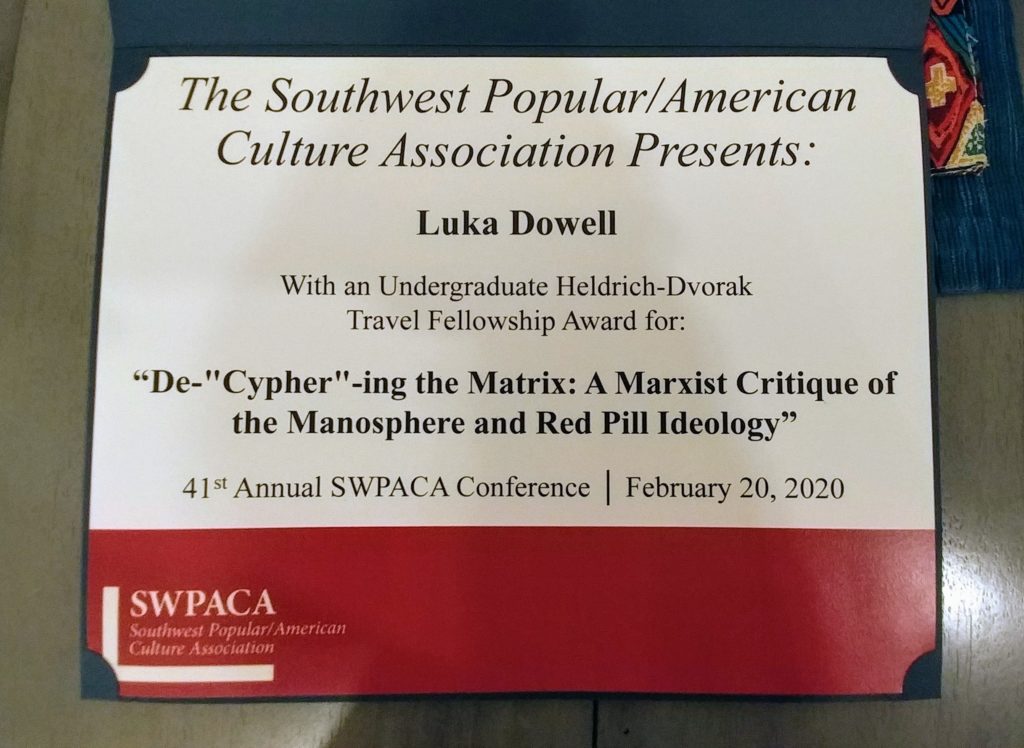Two weeks ago, I attended the annual SWPACA (Southwest Popular/American Culture Association) Conference in Albuquerque, New Mexico. The SWPACA Conference hosts scholarly research on popular and American culture from a number of disciplines. Personally I’m a bit out of touch with popular culture. I don’t watch a lot of TV shows or movies, and the conference program was full of media and cultural objects I’d never heard of. But in the end it didn’t matter too much—beyond the media/source material, what was most interesting about SWPACA was the variety of original ideas and theories from a wide range of interdisciplinary perspectives. There was still plenty to appreciate about the presentations I saw, even when the source material was unfamiliar.


Though it was my first ever academic conference and I was attending on my own, it wasn’t intimidating like I feared—as soon as I arrived for registration on day 1, more than anything I felt welcomed. Even surrounded by strangers—most of them graduate students, professors, and other scholars much older than I—it was easy to socialize and make friends. It seemed like we were all on the same page, or wavelength, or something like that. Everyone I met was ready to engage the same way I wanted to engage: explaining fresh and interesting theories, getting critical/analytical about everything, sharing philosophy memes, that sort of thing. I was more social in those few days than I have been in a very long time, because with this crowd I felt more comfortable and engaged doing so.
But I have to wonder: is this everyone’s experience at SWPACA? How universal was this feeling of friendliness and hospitality that I enjoyed so much? As a white American who could afford the expenses of attending out of my own pocket, aside from my gender and sexuality, I’m pretty much within the demographic that academia has historically been intended for. How much of my feeling-at-home was due to the lack of (institutional, economic, language) barriers I faced in getting there? I didn’t have to gain approval to travel to the U.S., nor did I face racial discrimination in any application process, and I got to speak my native language the whole time I was there. This isn’t to say that I think SWPACA is discriminatory, rather, academia as a whole is built on a legacy of exclusion and exclusivity and I think it’s fair to say we haven’t yet fully overcome that history nor resolved the inequalities it produced (and still produces).
This brings me to a particular slogan I came across at the conference:

“If it’s not popular, it’s not culture.” That’s what the banner at the registration desk said, so it was on my mind from the start. It’s a strong claim. So, being the sort of person I am, I started formulating counterarguments immediately, determined to find points of disagreement. The rest of this blog post is about that process, what SWPACA taught me, and how all the outstanding presentations/panels I saw gave me a better appreciation of culture—popular or otherwise.
As it turns out, it’s really hard to find a good definition of “popular culture” online. The best I found was a paragraph from Oxford Bibliographies, which defines popular culture as, “the set of practices, beliefs, and objects that embody the most broadly shared meanings of a social system.” Furthermore, popular culture (or mass culture) is “differentiated from high culture and various institutional cultures.” I think this definition offers the best (most likely intended) interpretation of the SWPACA slogan. The slogan speaks to an anti-elitist sentiment that I can definitely get behind. A lot of academic discourse is dense and unwieldy, full of jargon that makes it really difficult for a layman to follow along. And what’s the point of ideas, especially potentially revolutionary/world-changing ideas, if only a select few can understand them? Ideas/theories in isolation are of limited value; it’s when they’re communicated and transmitted with others that things get interesting. And popular culture does this transmission really well—by appealing to a layman instead of specialized audience, it can travel more widely. This is where I agree with the slogan, “If it’s not popular, it’s not culture”—if there isn’t an audience or following behind an idea, the idea doesn’t have much traction. An idea needs a large support base to grow beyond the confines of the original text or author and become relevant to culture in general.
But “popular” isn’t always a good thing. “Popular” seems to just mean an idea is dominant or at least widespread enough to be culturally significant; it has nothing to say about the idea itself. There are a lot of ideas that I think are bad, so an increase in popularity for those ideas would also be bad. For example, we’ve seen a resurgence recently in white nationalism, but that increased popularity certainly isn’t something I’d condone or encourage. I’m sure you can think of other examples of popular ideas you’d like to see become unpopular.
The obverse of this is that some unpopular ideas might be good, and might therefore deserve more recognition and wider cultural transmission. A common element of all the presentations and panels I enjoyed at SWPACA was that the speakers brought unique ideas and theories to the discussion of their source material. I enjoyed thinking about popular culture objects from new and previously unheard-of perspectives. I think the introduction of the unpopular (at least the not-yet-popular) to the popular—applying fresh perspectives to familiar material—is an important part of keeping culture alive. Today’s unpopular ideas might someday be at the forefront of popular culture. As a historical example, LGBT+ pride has grown from its roots in the Stonewall riots to huge yearly celebrations across the country, as well as legislative changes to expand the rights/protections for LGBT+ people. The popular emerges, grows from the once-unpopular. Thus, the unpopular is a necessary driving force in producing popular culture. But it’s not the only force at play.
Popularity means profitability, so companies are eager to seize upon popular ideas for their own ends. Surely most (if not all) of the increase in corporate support for LGBT+ causes is because marketing/advertising at pride parades, or using pro-LGBT+ sentiment conspicuously in advertising, is profitable. This is why emergent ideas in popular culture get co-opted and turned into marketing tools. Now, when we see queer representation in media, we (queer people) wonder if this representation comes from a legitimate respect for diversity or if we’re just being pandered to as a consumer demographic. Scholars studying popular culture have to take this nuance into account. And they do! At SWPACA, there were some great conversations about stereotypes, misrepresentation, and the consequences of commodification. “Popular” is just a measure of the audience or support base for a particular thing (idea, theory, media object, etc.). We also have to ask who the audience is, whether a popular thing is good or bad, whether it’s liked or disliked. And we have to ask how/why a popular thing was produced.
I wasn’t satisfied with the Oxford Bibliographies definition of popular culture because it seemed to conflate two different things: objects, and the cultural practices around those objects. The definition included both “a set of commodities produced through capitalistic processes” and “subcultures such as youth cultures or ethnic cultures.” I don’t think either definition is adequate on its own. Firstly, commodities on their own aren’t culture (or inherently popular), they’re just objects with the potential to become part of a culture and/or gain popularity. Popularity requires an actual audience, not just the possibility of one. Secondly, “subcultures” (especially “ethnic cultures”) aren’t always popularly accepted by the dominant culture—rather, they may even face oppression/suppression or be devalued by a cultural hierarchy (hence the “sub” prefix).
The word “popular” implies an audience. Merriam-Webster defines “popular” as “suitable to the majority”, “widely accepted”, or “relating to the general public.” But who is this “general public”? Who composes the “majority”? When we imagine a society as a single abstract entity, we ignore all the possible distinctions between individuals/groups in that society. Subcultures exist, and even non-dominant cultures/ideas can be significant. There is no single American or popular culture—the dominant culture of a certain time/place is informed by the interplay of subcultures exerting their influence over each other (this is why we can talk about “culture wars”). Popularity is constantly in flux, because dominant cultures/ideas are exposed to contestation from non-dominant ones. This process of constant contestation keeps culture and cultural discourses alive, rather than stagnant—the popular emerges from the unpopular when the old falls out of favor for the new (or the previously suppressed/forgotten).
This blog post got very abstract and I wanted to include more specific examples, but I guess it’s hard when talking about something as big and general as “popular culture.” This just goes to show how talking about “popular culture” in the abstract might not be as interesting as looking at specific subcultures through unique perspectives. That’s what I enjoyed so much about SWPACA—every presenter and panelist had their own original voice to contribute, their own part of the story. Being at a conference, surrounded by hundreds of voices from a range of disciplines, was so much more engaging than one person’s essay on “popular culture” in the abstract could ever be. A collective experience can’t be explained by a single individual’s perspective. It’s way more impactful to get out there and participate. Ideas and media objects (blog posts included) don’t make the culture on their own; we make cultures when we collectively engage with these objects.
In the end, I don’t entirely disagree with “If it’s not popular, it’s not culture.” We just have to be careful with our definitions (and our politics). The slogan made a great jumping-off point for my thinking about media and fandoms, and SWPACA exposed me to a huge variety of texts, ideas, and methods of study that will continue to inspire me. That said, we should remember that popularity isn’t equally accessible to everyone, and that “popular” isn’t always good—we have to ask who a thing is “popular” for, and who might not be included or actively excluded (either from accessing popular things or achieving popular recognition). Furthermore, there is no one “culture,” and we have to pay attention to viewpoints/ideas that don’t have the support of a dominant culture behind them. Popularity is in constant flux, informed by shifting cultural pressures. Popular culture is what happens when we gather collectively around the objects/ideas that are important to us now, and I believe popular culture is at its best when we invite as many voices to the conversation as possible.

A big thanks to SWPACA for helping fund my trip! I was honored to receive a Heldrich-Dvorak Travel Fellowship for my paper, “De-Cypher-ing the Matrix: A Marxist Critique of the Manosphere and Red Pill Ideology”. You can learn more about SWPACA here.